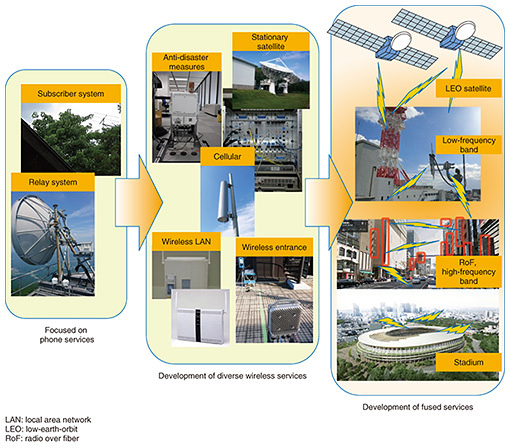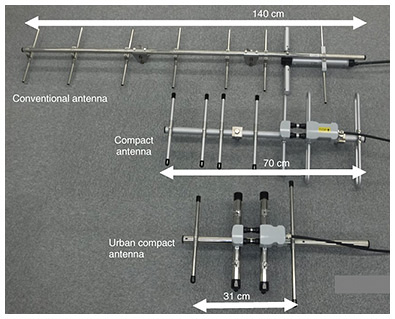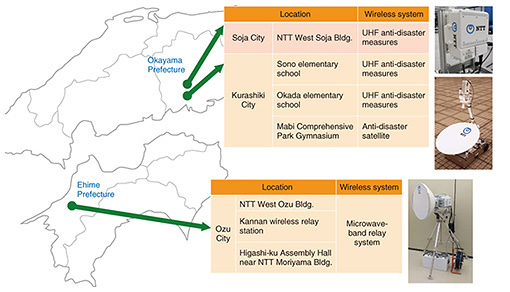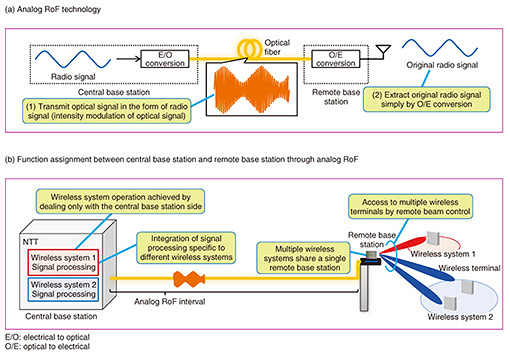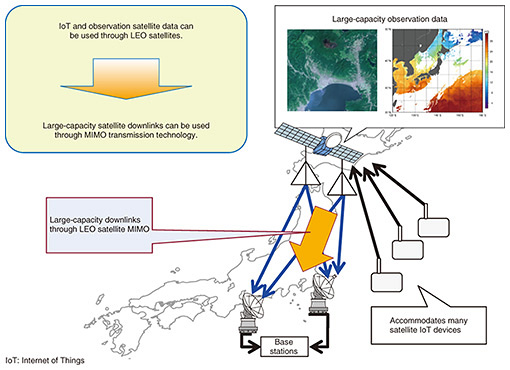 |
|
|
|
|
|
Feature Articles: Keynote Speeches/Workshop Lectures at Tsukuba Forum 2019 Vol. 18, No. 4, pp. 49–55, Apr. 2020. https://doi.org/10.53829/ntr202004fa8  Wireless Systems Technologies for Present and Future ServicesAbstractThe NTT Group provides a wide variety of services to its customers, and wireless technologies have an important role in supporting these services. Various methods of using wireless services are provided according to the characteristics of the frequency bands. This article introduces research and development directions in wireless technologies for supporting wireless services in the very high frequency (VHF), ultra-high frequency (UHF), microwave, and millimeter-wave bands. We also discuss the current state and future expansion of satellite communications and wireless local area networks (LANs). Keywords: VHF/UHF/microwave/millimeter-wave bands, satellite communications, wireless LAN 1. IntroductionNeeds and usage scenarios for wireless communication systems as a communications infrastructure continue to expand. In particular, traffic generated by mobile communications is increasing due to the widespread use of smartphones and tablet terminals. The development of wireless services and their spread is shown in Fig. 1. Past wireless services focused on telephone services such as subscriber systems and relay systems. This was followed by wireless services being more integrated into daily life as diverse wireless systems were developed and deployed independently such as cellular systems, satellite systems, and wireless local area networks (LANs). In the near future, we can expect the linking and fusing of these wireless systems. Current wireless systems will be enhanced by using a wide range of frequencies from low-frequency bands to high-frequency bands, i.e., from very high frequency (VHF) bands to millimeter-wave bands, by using new systems applying low-earth-orbit (LEO) satellite and radio-over-fiber (RoF) technologies, and by fusing these current wireless systems with high-density wireless LANs. To meet high expectations for these wireless services, NTT Access Network Service Systems Laboratories is researching and developing methods of exploiting the advantages of these systems. These wireless systems enable a highly convenient world in which all manner of things are connected through wireless technologies.
At the same time, our research and development (R&D) efforts have been focused on anti-disaster measures since the Great East Japan Earthquake of 2011. These include studies of wireless systems for dealing with disasters by quickly restoring and constructing the communications infrastructure after a wide-area disaster, which could greatly impact customers. We have been upgrading and enhancing various types of wireless systems for conventional anti-disaster systems and for the revised spurious-emissions standard. To achieve even higher transmission speeds in the face of expanding usage scenarios for wireless communication systems, recent studies considered technologies for using even higher frequencies in the millimeter-wave band. One of these studies focused on the rapid traffic increase in urban areas. This study aimed at applying millimeter-waves to wireless entrance systems connected to remote base stations for small cells, large numbers of which will likely to be necessary in the future. Connecting wireless entrance systems to small-cell remote base stations in place of optical fibers will enable flexible base-station-deployment design. We are studying high-frequency-band analog RoF technology for softwarizing wireless transmit/receive functions for wireless central base stations. This study is proceeding in the direction of minimizing power consumption of remote base stations and inheriting the advantages of cellular stations such as compact and low-power characteristics. Attention has also been on satellite communication systems in the wake of the Great East Japan Earthquake because of their inherent features such as wide-area and immediate communications. However, conventional satellite communication systems at that time suffered from old equipment and obsolete operational maintenance procedures. This led to the development of high-efficiency signal-processing equipment for disaster control and earth stations on remote islands where the laying of optical fiber is difficult. The grouping of this equipment into systems has also progressed. There have also been recent studies on applying LEO satellites to satellite communication systems to explore their use in future communications. Wireless LANs are also making great progress beyond their conventional role of being just a means of communications in unlicensed bands. It is becoming a system that can significantly expand the reach of users. Therefore, various rich services, i.e., those that have high-efficiency and high-density performances, are being provided through the current and further development of wireless LANs. In the following sections, we introduce our current R&D directions in these wireless technologies. 2. VHF/UHF /microwave-band wireless systemsWe first introduce our R&D activities using the VHF, ultra-high frequency (UHF), and microwave bands. We describe anti-disaster systems using the UHF band for wide-area disasters that have attracted interest following the Great East Japan Earthquake. We used these systems including a microwave band system for the torrential rain that fell over western Japan in July 2018. The NTT Group considers the construction of a network robust against disasters and the means of providing early restoration after a disaster as critical issues. Our wireless communication systems for anti-disaster measures are advantageous in terms of equipment mobility and early restoration. However, the problems of aging facilities and a lack of personnel with specialized skills are only becoming worse. Thus, the need has arisen for upgrading facilities and improving their operability and maintainability. Based on this background, we developed an anti-disaster wireless communication system with a range of several tens of kilometers using the UHF band. From lessons learned from the Great East Japan Earthquake, this system was also designed to provide a point to multi-point communication configuration, which can consist of multiple wireless terminal stations and a single wireless base station. It was also developed under a variety of requirements such as the provision of Internet-connection functions in addition to special public telephones and the capability to deal with wide-area disasters brought on by mammoth earthquakes and tsunamis. We improved the mobility and operability/maintainability of equipment such as through compact and lightweight designs. We developed in parallel with this system a compact antenna using a phased array method with a total length one-half that of conventional antennas as well as an even smaller antenna for urban use (Fig. 2).
Examples of UHF and microwave band systems used in response to the torrential rains in western Japan are shown in Fig. 3. Specifically, UHF anti-disaster systems were used in Okayama Prefecture, and a microwave-band relay system was used in Ehime Prefecture.
From the viewpoint of applying the VHF band to regions where wired equipment is difficult to install, such as national parks and super-rural areas outside mobile-phone coverage, the effects of long-delay waves must be clarified considering the need for long-distance signal propagation. For this reason, we are conducting basic studies on signal propagation by performing actual signal-propagation measurements to formulate a radio propagation model. We are also clarifying the feasibility of applying multiple-input multiple-output (MIMO) transmission technology to single-carrier systems in VHF band systems. 3. Millimeter-wave band wireless systemsIn this section, we introduce studies using the millimeter-wave band as an approach to using high-frequency bands. In particular, we describe wireless entrance technology and RoF technology as countermeasures to rising volumes of traffic in urban areas. Optical fibers are commonly used when connecting many small-cell remote base stations. However, it is expected that an even greater number of small-cell remote base stations will be used in the future, suggesting that wide-band and high-frequency wireless entrance technologies will become essential. We can expect efficient construction of the front-haul section through flexible use of wireless entrance technologies in combination with optical fibers. Therefore, we experimentally verified the performance of a wireless-entrance approach using millimeter waves. Assuming a front-haul interface based on a function assignment between a central base station and remote base stations and a transmission speed within 10 Gbit/s, we evaluated wireless transmission performance intervals of 20 and 50 m. The experimental results indicated that no major degradation in transmission performance could be found compared with using optical fibers. R&D is also progressing in wireless systems using high-frequency-band analog RoF for directly converting millimeter-wave radio signals to optical signals for transmission through optical fibers. High-frequency-band analog RoF technology uses radio-signal-processing in a central base station and connects antennas to a remote base station via optical fiber (Fig. 4). With this scheme, we can expect the remote-base-station side to take on a simplified and low-power configuration. When many remote base stations come to be deployed in the future, this scheme will make it possible to achieve remote beam control by implementing beam forming technology, which is essential to millimeter waves, only in central base stations. These millimeter-wave technologies are being investigated and developed for application in the beyond 5G (fifth-generation mobile communications) era.
4. Satellite communicationsWe now describe our R&D of satellite communication systems. In the aftermath of the Great East Japan Earthquake, attention turned to the distinctive features of satellite communication systems such as wide-area and immediate communications. Therefore, we developed high-efficiency signal-processing equipment for earth stations applicable to remote islands and anti-disaster approaches. Satellite communications are in the midst of a great transformation on a global scale. We are investigating the application of communications not only to stationary satellites used in conventional communication systems but also to LEO satellites. To explore the expansion of satellite communications, we are studying a MIMO transmission technique for applying MIMO technology to LEO satellite systems. A model of MIMO transmission using a LEO satellite is shown in Fig. 5. The basic results of this study indicate that transmission capacity can be increased when using multiple antennas on a LEO satellite to achieve large-capacity performance for downlinks. We intend to continue our R&D efforts in this area to find new uses of space.
5. Wireless LANsIn this section, we describe recent R&D activities focusing on wireless LANs. While participating in the IEEE 802.11 committee and a variety of organizations such as the Association of Radio Industries and Business (ARIB), we have been promoting R&D of wireless LANs not only in terms of technology but also of standardization and regulations. Wireless LANs are dramatically advancing not only as means of communications, as in conventional LANs using unlicensed bands, but also in regards to usage scenarios. A wireless LAN is a system that greatly extends the user’s reach. In addition to advanced specifications such as high-quality, large-capacity, and low-latency transmission, wireless LANs are contributing to a variety of services through new deployments in non-communication areas such as positioning, visualization of radio quality, and object detection by radio waves. Recent verifications involving crowds of around 10,000 people at large stadiums or exhibit halls have demonstrated the huge potential of all-member new-experience-type events, which use a large-scale Wi-Fi network environment to enable a simultaneous content-sharing experience. 6. Future outlookFor future study, we plan to continue our R&D activities to provide our customers with wireless services, which are all the more convenient, while supporting a wide variety of existing wireless services. |
|









